Musical Characteristics of Local Brass Band in Lower Northern Thailand ลักษณะทางดนตรีของแตรวงพื้นบ้านภาคเหนือตอนล่าง
Main Article Content
Abstract
The purpose of this paper was to investigate musical characteristics of local brass bands in lower northern Thailand. The study was part of a research examining local brass bands’ adjustment in lower part area of northern Thailand. For the accuracy of musical characteristic presentation, the study particularly examined the bands with at least 40 years of age. Nine bands from nine different provinces were chosen. In this qualitative study, data were collected from the field study and participant interview. The results of the study of musical characteristics on the topics of rhythm, melody, harmonization, color of music and lyric showed that the musical characteristics could be divided into 2 groups The first group included the band playing Thai local dancing song (Ramwong), march music, folk songs, country music, and Thai songs. Many brass bands underlying this category were commonly played in a naga ordination ceremony or a funeral. Such bands were from Tak, Uttaradit, Phitsanulok, Phicit, and Phetchabun which particularly built its uniqueness by including an E-san reed-mouth organ (Khene) into the band. The second group included bands playing only funerals. These were bands from Sukhothai, Kamphaeng Phet, Nakhon Sawan, and Uthai Thani. It was special and resulted from the musical characteristics of Uthai Thani Province which found the most harmonization among the instruments which presented its particularity by adding international music notation and Ranat-ek into the band. The inclusion of Thai instruments into the bands yielded Thai rhythm, melody, and form. Such music characteristics indicated that local brass bands in lower northern Thailand had increasingly used Thai music instruments. This might result from the popular trend of an ordination musical performance relying on parade float car in which certain types of string band music instruments (e.g., bass guitar, and team drum) played significant role. As a result, the local brass bands had to modify their musical characteristics to meet more social needs.
Downloads
Article Details
References
Amatayakul, P. (1981). Crown Prince with music. Bangkok: Chanwanich.
Charoensook, S. (2000). Beass and Brass of the Siamese. Bangkok: DoctorZack.
Nakpee, P. (1994). Thai Folk Music. Phitsanulok: Department of Music, Faculty of Humanities and Social Sciences, Naresuan University.
Pikulsri, C. (2017). Change in Music. Khon Kaen: Graduate Studies Textbook Project branch of music Faculty of Fine and Applied Arts, Khon Kaen University.
Pukhaotong, S. (1981). Thai music and Guidelines for entering Thai music. Bangkok: Department of Music, Bansomdejchaopraya Teacher College.
Rojanatrakul, S. (2016). Brass Band. Bangkok: Odeon Store.


